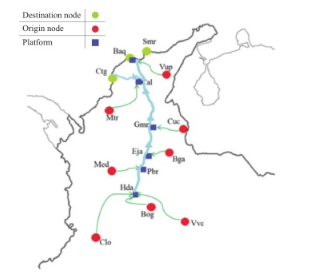Logistic platform placement for harmonious development of the nation’s intermodal network
DOI:
https://doi.org/10.25043/19098642.173Keywords:
logistics platform, intermodal transport, multi-facility localization problemAbstract
This article considers the problem of locating multiple installations for the intermodal transport network in Colombia, and is based on the analysis of the transport of cargo from the main generating cities to the three most important port cities in the Caribbean region of the country: Barranquilla, Cartagena and Santa Marta; integrating the modes of transport by land, road and river. According to this, land transport by road is used from the source of cargo to the possible locations of the logistic platforms, and then the Magdalena River basin is used as a unique river corridor.
The model proposed consists of determining the optimal location of a series of logistic platforms that guarantee a system of integration and cooperation in transport strategies for the country, in which aggregation and disaggregation of freight operations will be possible. In this aspect, an entire mixed programming model is performed with the objective of minimizing the total costs of transport and operation of the new intermodal network, with restrictions associated with the generation and processing of cargo, obtaining results in the cost functions related to cargo transport and leaving as evidence the potential of integrating intermodal transport for the country's competitiveness.
Downloads
References
AKYUZ, M., ONCAN, T., & ALTNEL, L. (2009). The multi-commodity capacitated multi-facility Weber problem: Heuristics and confidence intervals. Proceedings of the international multiconference of engineers and computer scientist, 2.
ARABANI, A., & FARAHANI, R. (2011). Facility location dynamics: An overview of classifications and applications. Computers & Industrial Engineering, 408-420.
BALLOU, R. (1968). Dynamic warehouse location analysis. Journal of Marketing Research, 271- 276.
FARAHANI, R., & HEKMATFAR, M. (2009). Facility Location: Concepts, Models, Algorithms and Case studies. Berlin; Germany: Springer Verlag Berlin Heidelberrg.
GÓMEZ T, A. (2012). Strategic analysis of the shipyard Sector in Colombia: study from a Fluvial perspective. Institute of Studies for Development-IDE, University of Technology of Bolívar, Colombia.
HALE, T., & MOBERG, C. (2003). Location Science Research: A Review. Annals of Operations Research, 123(1), 21-35.
HEKMATFAR, M., & PISHVAEE, M. (2009). Hub location problem. In R. Farahani & M. Hekmatfar, Facility location: Concepts, models, algorithms and case studies (pages 243-270) BERLIN Germany: Springer Verlag Berlin Heidelberg.
MINISTRY OF TRANSPORT OF COLOMBIA (2015). Intermodal Transport Master Plan (PMTI): A State policy to make Colombia a more competitive country.
MINISTRY OF TRANSPORT OF COLOMBIA (2015). System of Information of Efficient Costs for SICE-TAC Cargo Automotive Transport. Available [www.Ministry of Transport.gov.co].
MINISTRY OF TRANSPORT OF COLOMBIA (2013). Origin-destination matrix national freight.
NATIONAL ASSOCIATION OF INDUSTRIALISTS, ANDI. (2016). National Competitiveness Report 2016-2017. Bogotá.
OSPINA HERNÁNDEZ, M. (2008). Fluvial navigation in Colombia. Cartagena de Indias.
REPUBLIC OF COLOMBIA (2015) . Fluvial master Plan of Colombia. Bogotá, Colombia.

Published
How to Cite
Issue
Section
License
The authors who publish in this Journal certify that:
- The work submitted for publication in The Ship Science and Technology journal, was written by the author, given that its content is the product of his/her direct intellectual contribution.
- All data and references to material already published are duly identified with their respective credits and are included in the bibliographic notes and quotations highlighted as such.
- All materials submitted for publication are completely free of copyrights; consequently, the author accepts responsibility for any lawsuit or claim related with Intellectual Property Rights thereof, Exonerating of responsibility to The Science and Technology for the Development of Naval, Maritime, and Riverine Industry Corporation, COTECMAR.
- In the event that the article is chosen for publication by The Ship Science and Technology journal, the author state that he/she totally transfers reproduction rights of such to The Science and Technology for the Development of Naval, Maritime, and Riverine Industry Corporation, COTECMAR.
- The authors retain the copyright and transfer to COTECMAR the right of publication and reproduction of the work which will be simultaneously subject to the Creative Commons Attribution License (CC -BY) , which allows the license to copy, distribute, display and represent the work and to make derivative works as long as it recognizes and cites the work in the manner specified by the author or licensor.
- For more information about the Creative Commons Attribution License (CC -BY) and his use and scope, please visit the following web page https://creativecommons.org/licenses/by-sa/4.0/legalcode








